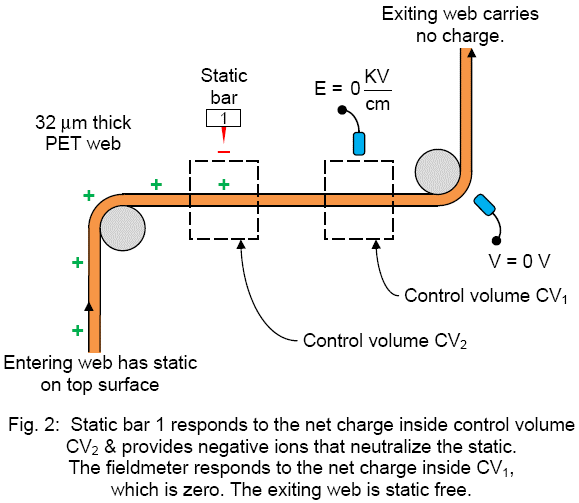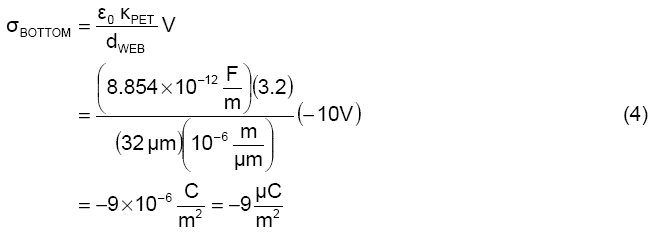Net and Polar Charge
- Published: September 23, 2012, By Kelly Robinson

How does knowing about this difference between “net charge” and “polar charge” help solve static problems?
The terms “net charge” and “polar charge” are jargon. While technical jargon is often just confusing code, these two terms refer to important concepts. Net charge is just the total charge carried by a web. The entering web in Fig. 1 carries positive static charges. The location and amount of the charge on the web may be determined by using an electrostatic fieldmeter and a non-contacting electrostatic voltmeter to make two measurements. The electrostatic fieldmeter responds to the sum of the charge densities on the top and bottom surfaces of the web inside volume CV1. The sum of the charge densities is computed in (1).

The fieldmeter responds to the “net charge” on the web, which is the sum of the charges on the top surface and the bottom surface.
The electrostatic voltmeter in Fig. 1 responds to the charge on the exposed, bottom surface of the web. Since the voltmeter reads zero, the bottom surface of the web carries no charge.

Knowing the readings of the fieldmeter and the electrostatic voltmeter, we know that all of the static charge is on the top surface.


The entering web in Fig. 2 carries +9 µC/m2 of static charge on the top surface. Static bar 1 is well positioned to neutralize static on the top surface of the web. The static bar responds just like a fieldmeter. Draw control volume CV2 enclosing the web in front of the static bar. The charge density inside CV2 is +9 µC/m2 and static bar 1 responds by providing negative ions that deposit on the top surface.
Our two static measurements confirm that our static bar is effective. The electrostatic fieldmeter reads zero indicating that the sum of the charge densities on the top and bottom surfaces of the web are zero. And, our non-contacting electrostatic voltmeter reads zero confirming that the charge density on the bottom surface is zero. The exiting web in Fig. 2 carries no charge. Our static control system is well designed and functioning properly.

The entering web in Fig. 3 carries +9 µC/m2 of static charge. Our two static measurements in Fig. 1 confirm that the charge is all on the top surface. However, static bar 2 is improperly located to deposit static charge on the bottom surface. Static bar 2 responds just like a fieldmeter. Draw control volume CV2 enclosing the web in front of the static bar. CV2 encloses web with a charge density of +9 µC/m2 so the static bar provides negative ions that deposit on the bottom surface of the web. The fieldmeter reading in Fig. 3 confirms that the charge densities on the top surface and the bottom surface sum to zero. The net charge on the web is zero.
However, the electrostatic voltmeter responds to the charges on the bottom surface of the web and reads –10V. The charge density on the bottom surface is calculated in (4).

Our static bar has deposited negative charge on the bottom surface of the web that is equal in magnitude to the positive charge density on the top surface of the web. This is polar charge; the pattern of charge where one web surface has positive charge and the other surface has an equal amount of negative charge.
The static bar in Fig. 2 installed on the correct side of the web neutralizes static. The exiting web in Fig. 3 carries polar charge. The static bar in Fig. 3 fails to neutralize the static charges on the web. Instead, it converts net charge into polar charge. When a web carrying polar charge is wound into a roll, the roll will be a “hot roll.” The winding roll will develop a large electrostatic potential possibly causing sparks and shock to operators.
I invite you to share your comments on this blog below. And, please feel free to suggest topics for future blogs.
My email address is:
Kelly.Robinson@ElectrostaticAnswers.com .
Please feel free to visit my website:
www.ElectrostaticAnswers.com .








